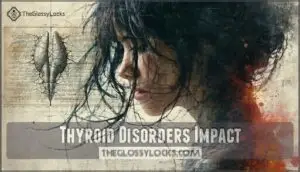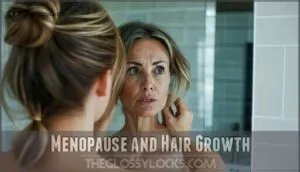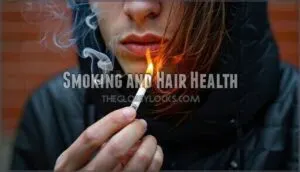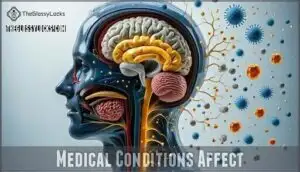This site is supported by our readers. We may earn a commission, at no cost to you, if you purchase through links.

The main causes of slow hair growth include genetics—you can’t outrun your family tree—plus hormonal imbalances like thyroid issues or fluctuating androgens.
Poor nutrition starves your hair of essential building blocks, while chronic stress literally chokes off blood flow to your scalp.
Environmental toxins, certain medications, and autoimmune conditions also slam the growth cycle into low gear.
Even your lifestyle choices, from smoking to crash dieting, can turn your hair follicles into lazy underperformers.
The trick lies in identifying which combination of culprits is sabotaging your specific situation.
Table Of Contents
- Key Takeaways
- Hair Growth Basics
- Genetic Factors Influence
- Hormonal Imbalance Effects
- Environmental Factors Matter
- Lifestyle Choices Impact
- Medical Conditions Affect
- Frequently Asked Questions (FAQs)
- Why does my hair grow so slowly?
- What causes hair loss & slow hair growth?
- Why is my hair not growing?
- Why does my hair grow faster?
- What causes hair loss?
- Does hair growth slow down with age?
- Why is my hair growing so slowly?
- What am I lacking if my hair isn’t growing?
- What inhibits hair growth?
- Does hair grow slower as you age?
- Conclusion
Key Takeaways
- Your genetics set the foundation for hair growth speed – If your family has a history of slow hair growth or pattern baldness, you’re likely dealing with inherited factors that determine your follicles’ growth potential and cycle length.
- Hormonal imbalances are major growth disruptors – Thyroid disorders, androgen excess from conditions like PCOS, and menopause-related estrogen decline can slow your hair’s growth cycle or cause follicles to shrink and stop producing healthy strands.
- Poor nutrition starves your follicles of essential building blocks – Iron deficiency, low vitamin D, inadequate protein, and zinc deficiency create roadblocks that prevent your hair from reaching its growth potential, even when you’re doing everything else right.
- Chronic stress literally chokes off blood flow to your scalp – Elevated cortisol levels push your hair follicles into premature resting phases, while stress-induced scalp tension restricts the oxygen and nutrients your follicles need to thrive.
Hair Growth Basics
Your hair follows a predictable three-phase cycle that determines how fast it grows and when it sheds, with about 90% of your hair currently in the active growth phase called anagen.
Your hair’s destiny is written in its three-phase cycle—90% of your strands are actively growing right now.
Understanding this natural process helps you recognize whether your hair’s growth rate of roughly half an inch per month is normal or if underlying factors are slowing things down, which can be influenced by the fact that your hair is in the active growth phase for a significant portion of the time, specifically the anagen phase.
Anagen Phase Importance
The anagen phase acts as your hair’s engine room, where approximately 90% of your follicles actively produce new strands.
This active growth stage determines your hair’s growth potential, lasting 2-8 years depending on follicle health and genetics.
When anagen duration shortens or phase extension fails, you’ll notice slower growth and reduced length capabilities, which is influenced by the anagen phase.
Hair Cycle Phases
Your hair follows a predictable four-stage journey that determines growth success.
The anagen phase drives active growth for 2-7 years, while catagen signals a shift over several weeks.
Telogen shedding naturally releases 50-100 hairs daily during the resting period, followed by exogen impact as new strands emerge.
Cycle disruption from stress or hormones can halt this process entirely.
Average Hair Growth Rate
Most people expect their hair growth rate to match what they see online, but reality tells a different story.
Your strands typically grow about half an inch monthly, though this varies substantially based on several factors:
- Age Influences: Growth slows roughly 10% per decade after thirty
- Ethnicity Factors: Asian hair often grows fastest, while African hair grows slowest
- Seasonal Variation: Summer months typically show increased hair growth speed
Genetic Factors Influence
Your family’s genetic blueprint determines how fast your hair grows, just like it influences your height and eye color.
If your parents and grandparents experienced slow hair growth or thinning, you’re likely carrying the same genetic instructions that control your hair follicle behavior, growth cycle length, and overall hair health potential, which is influenced by your family’s genetic makeup.
Family History Role
Your family tree holds clues about your hair’s future.
Genetics determine your hair growth timeline and potential for pattern baldness.
If relatives experienced inherited thinning, you’re likely facing similar hair growth problems.
Understanding these family traits helps identify genetics and hair growth connections affecting your strands.
Genes also play a role in determining hair texture.
| Family History Factor | Impact on Hair Growth |
|---|---|
| Male Pattern Baldness | 50% chance if father affected |
| Female Pattern Thinning | Higher risk with maternal history |
| Early Onset Hair Loss | Often appears at similar ages |
| Thick Hair Genetics | Determines maximum hair density |
| Growth Rate Patterns | Inherited speed of hair growth |
Genetic Predisposition
Some inherited traits determine your hair’s growth potential before you’re even born.
Your genetics control everything from hairline recession patterns to hair texture and thickness.
If slow hair growth runs in your family, genetic testing can reveal hereditary factors affecting your follicles.
Understanding these genetic influences helps you set realistic expectations for your hair’s natural growth capabilities.
Inherited Hair Growth Patterns
Your genetic blueprint determines more than eye color—it sets your hair’s destiny.
Pattern baldness genes, inherited hair density, and follicle size inheritance create your unique hair growth patterns.
Here’s what you’ve inherited:
- Genetic hair length limits that cap maximum growth
- Hair growth speed predetermined by family DNA
- Follicle strength affecting thickness and longevity
Understanding these inherited hair growth causes helps manage realistic expectations.
Hormonal Imbalance Effects
Your hormones act like a control center for your hair growth, and when they’re out of balance, your hair follicles can’t function properly.
Your hormones are the puppet masters pulling the strings behind every strand that grows—or doesn’t.
Thyroid disorders, androgen imbalances, and menopause all disrupt the normal hair growth cycle, causing strands to grow slower, become thinner, or stop growing altogether, which is a result of hormones being out of balance.
Thyroid Disorders Impact
Your thyroid acts like your body’s master controller, and when it’s off-balance, your hair pays the price.
Hypothyroidism effects include dry, brittle strands that break easily, while hyperthyroidism impact causes thinning across your entire scalp.
TSH levels outside normal ranges disrupt your hair’s growth cycle, but thyroid medication and hormone replacement can restore healthy growth patterns.
Autoimmune conditions like Hashimoto’s can lead to thyroid related hair loss.
Androgen Imbalance Consequences
When androgens like testosterone and DHT overwhelm your system, they trigger androgenetic alopecia by shrinking hair follicles.
This hormonal imbalance affects millions, creating a domino effect that stops healthy growth in its tracks.
Recent studies show that thyroid hormones impact follicle health, influencing hair growth.
Here’s how androgen excess sabotages your hair:
- DHT Sensitivity – Your follicles become hypersensitive to dihydrotestosterone
- PCOS Impact – Elevated adrenal androgens disrupt normal growth cycles
- Testosterone Levels – High concentrations miniaturize scalp follicles progressively
- Estrogen Deficiency – Reduced estrogen can’t counterbalance androgen effects
- Follicle Miniaturization – Hair becomes finer until it stops growing entirely
Menopause and Hair Growth
Menopause brings estrogen decline that directly impacts your hair’s thickness and growth rate.
This hormonal imbalance triggers female pattern hair loss, making strands thinner and more fragile.
Post-menopause care becomes essential for maintaining scalp health.
Hormone therapy might help, but you’ll need proper evaluation first.
Hair thinning during this phase affects millions of women worldwide, highlighting the importance of hormone therapy.
Environmental Factors Matter
Your daily environment creates a battleground for your hair follicles, where pollution particles clog pores, UV rays break down protein structures, and cigarette smoke reduces oxygen flow to your scalp.
These external factors don’t just damage existing strands—they actively slow new hair production by disrupting the natural growth cycle at the cellular level, which is a critical aspect of hair health and involves the cellular level.
Pollution and Hair Growth
Air pollution doesn’t just hurt your lungs—it’s silently sabotaging your scalp health too.
Fine particles penetrate your scalp, triggering inflammation that disrupts hair growth cycles. Pollutant exposure creates oxidative stress, damaging hair follicles at the cellular level.
Poor air quality accelerates hair damage through environmental factors beyond your control. Protective measures like covering your hair outdoors can shield against pollution’s harmful effects on hair growth, reducing the impact of pollution.
Sun Exposure Damage
UV rays beat down on your hair like a relentless hammer, breaking protein bonds and fading color.
Sun exposure weakens your hair shaft, leading to increased breakage and slower growth. Your scalp can suffer sunburn too, creating inflammation that disrupts follicles.
Use UV protection sprays, wear hats, and maintain proper hydration to shield your strands from environmental damage. Consistent sunscreen use can help with sun damage prevention, which is crucial for sun damage prevention.
Smoking and Hair Health
If the sun damages your hair, smoking takes it to the next level. It’s like putting your follicles on a slow drip of trouble.
Nicotine impacts scalp circulation, reducing follicle oxygenation. Toxins from cigarettes build up, causing hair brittleness.
Addressing smoking related hair loss may require specialized products. Here’s how smoking hurts hair growth:
- Weakens follicles
- Reduces blood circulation
- Promotes toxin accumulation
- Slows hair regrowth
- Encourages brittle strands
Lifestyle Choices Impact
Your daily habits play a more significant role in hair growth than you might realize, with everything from your morning coffee routine to your Netflix binge sessions affecting your follicles.
Poor nutrition, chronic stress, and sedentary behavior create a perfect storm that can slow your hair’s growth cycle and leave you wondering why your strands aren’t reaching their potential, due to the impact of chronic stress and overall lifestyle on hair health, ultimately affecting the hair growth cycle.
Diet and Nutrient Intake
Your hair follicles need proper fuel to thrive, just like your body needs food to function.
Nutrient deficiency, particularly iron deficiency and low vitamin D levels, can halt growth completely.
Without adequate protein intake, your hair can’t build strong keratin strands.
Zinc benefits include supporting follicle health, while hydration effects keep your scalp nourished for maximum growth.
Addressing hair thinning concerns can improve hair health and support overall follicle well-being.
Stress and Hair Growth
Chronic stress wreaks havoc on your hair growth through elevated cortisol levels.
When you’re constantly stressed, your body shifts hair follicles into telogen effluvium, causing premature shedding. Traumatic events can trigger this condition months later.
Stress hormones create scalp tension, restricting blood flow to follicles. Addressing stress related alopecia may help restore hair growth.
Managing your emotional wellbeing through relaxation techniques helps restore normal growth cycles.
Exercise and Hair Health
Regular exercise creates a winning combination for hair growth by boosting blood flow to your scalp and delivering essential nutrients to hungry follicles.
Here’s how physical activity transforms your hair health:
- Exercise circulation increases oxygen and nutrient delivery to hair roots
- Stress reduction balances cortisol levels that otherwise disrupt growth cycles
- Hormonal balance improves through consistent movement and activity
- Scalp sweat helps remove buildup while promoting scalp health
Consistent exercise can also help reduce oxidative stress effects, which is beneficial for hair health.
Medical Conditions Affect
Your body’s internal health conditions can secretly sabotage your hair growth efforts, even when you’re doing everything else right.
Medical issues like autoimmune diseases, vitamin deficiencies, and certain medications create invisible barriers that prevent your follicles from reaching their full growth potential, which can be a significant obstacle to achieving healthy hair growth.
Autoimmune Diseases
Your immune system can turn against your hair follicles, creating serious hair growth issues.
Alopecia Areata causes patchy hair loss when immune dysfunction targets healthy follicles. Cicatricial Alopecia permanently destroys follicles through scarring.
Systemic Lupus and other rheumatological disorders also trigger alopecia. Autoimmune treatments like corticosteroids can help restore growth.
| Autoimmune Condition | Hair Loss Pattern |
|---|---|
| Alopecia Areata | Circular bald patches |
| Cicatricial Alopecia | Permanent scarring |
| Systemic Lupus | Diffuse thinning |
| Rheumatoid Arthritis | General hair loss |
| Thyroid Autoimmune | Overall weakening |
Vitamin Deficiencies
Beyond immune system attacks, nutritional gaps can sabotage your hair’s growth potential.
Iron deficiency tops the list of hair growth deficiencies, starving follicles of oxygen they need.
Vitamin D and zinc deficiency create similar roadblocks, while poor nutrient absorption prevents biotin supplementation from working effectively.
However, it’s noteworthy that true biotin deficiency is relatively rare.
- Iron deficiency affects 25% of women worldwide
- Vitamin D levels below 30 ng/mL slow hair growth substantially
- Zinc deficiency reduces hair shaft diameter by 15%
Medication Side Effects
Your medicine cabinet might harbor hidden culprits behind your slow hair growth.
Chemotherapy drugs, blood thinners, antidepressants, and beta-blockers can all trigger hair loss as medication side effects.
These treatments disrupt your hair’s natural cycle, pushing follicles into premature rest or stopping growth entirely.
Drug interactions may worsen the problem, creating cascading effects on your hair’s health and thickness.
Frequently Asked Questions (FAQs)
Why does my hair grow so slowly?
Your hair’s crawling along like molasses because genetics, hormones, stress, and nutrient deficiencies are hitting the brakes.
Age naturally slows growth by 10% per decade after thirty, making patience your new best friend.
What causes hair loss & slow hair growth?
Genetics, hormones, stress, and aging naturally slow your hair’s growth cycle.
Nutrient deficiencies, thyroid issues, medications, and harsh styling damage follicles.
Your lifestyle choices directly impact how quickly your hair grows, and this is influenced by hormones.
Why is my hair not growing?
Like a garden during drought, your hair’s growth can stall when it lacks essential nutrients or faces stress.
Your follicles might be stuck in resting phase due to hormones, genetics, poor diet, or illness affecting their natural cycle.
Why does my hair grow faster?
Your follicles might be in an extended anagen phase, you’ve got great genetics.
Or you’re doing something right with nutrition and scalp care that’s keeping those growth cycles humming along nicely.
What causes hair loss?
Think of your scalp as a garden where various weeds can choke healthy growth.
Genetics, hormonal imbalances, stress, nutritional deficiencies, medications, autoimmune conditions, and aging all conspire to disrupt your hair’s natural cycle, causing unwanted shedding, due to factors such as genetics.
Does hair growth slow down with age?
Yes, your hair growth naturally slows as you age. After 30, hair growth decreases by about 10% each decade. Your follicles weaken, producing thinner strands, and growth cycles become shorter over time.
Why is my hair growing so slowly?
Your hair’s hitting the brakes due to genetics, stress, hormonal shifts, or nutrient deficiencies.
Age naturally slows growth by 10% per decade after thirty, while poor circulation and tight hairstyles also stunt progress.
What am I lacking if my hair isn’t growing?
You’re likely deficient in iron, zinc, or vitamin D—the big three for hair growth.
Protein, B vitamins, and vitamin C also play essential roles.
Blood tests can reveal what’s missing from your diet, and identifying these deficiencies is crucial for hair growth.
What inhibits hair growth?
Picture your follicles hitting the brakes—stress, hormonal imbalances, poor nutrition, and genetics can slam the door on growth.
You’re battling invisible enemies like cortisol, thyroid dysfunction, and vitamin deficiencies that secretly sabotage your strands.
Does hair grow slower as you age?
Your hair’s growth rate naturally declines by about 10% each decade after you hit
It’s like your follicles are hitting their own version of middle age, slowing down the production line considerably.
Conclusion
Sarah’s hair barely grew half an inch in six months despite expensive treatments, until blood tests revealed severe iron deficiency from her restrictive diet.
Understanding the causes of slow hair growth transforms your approach from guessing games to targeted solutions.
Whether you’re battling genetic predisposition, hormonal chaos, or lifestyle sabotage, identifying your specific triggers empowers effective treatment.
Don’t let multiple factors compound the problem—address nutrition gaps, manage stress levels, and consult professionals when needed for ideal results, leading to a more effective approach to hair growth.
- https://better-notyounger.com/blogs/the-better-blog/6-slow-hair-growth-causes-and-their-solutions
- https://asihairclinic.com/blogs/the-science-behind-hair-loss-stages-how-to-slow-them-down
- https://dermnetnz.org/topics/female-pattern-hair-loss
- https://www.researchgate.net/publication/373107628_Causes_and_treatments_of_hair_loss_A_cross-sectional_study
- https://pmc.ncbi.nlm.nih.gov/articles/PMC8808739/












